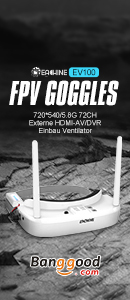Nun Haribo...im kleinen kannste das erleben wenn du dir für 50€ ein Billigflugzeug bei ebay kaufst und diese Kiste ums verrecken nicht fliegen/abheben wird (wenns kein Markenflugzeug wie Graupner oder MPX ist) weil billigste unterdimensionierte Komponenten verbaut sind. Das kannst dann hochmultiplizieren. Videobrillen gibts viele..trotzdem fliegen hier 90% mit Fatshark oder Headplay. Und wenn das Flugzeug (im Wert von einigen hundert Euro) runterkommt weil man am falschen Ende gespart hat (zb. billig Servo oder Empfänger)... das ist/wäre net wirklich lustig..

:
Alternativ auch noch die Team Black Sheep Rules ausm RCGroups Forum:
Before we get to the list, let me just point out that while these points reduce the possibility of technical failures resulting in the loss of your aircraft, they do not account for stupidity on behalf of the pilot. If you want to fly into a tree and you consequently lose your plane, well, you shouldn't have flown into the tree.
* Start with the bare essentials and add equipment one step at a time. after each new equipment was added do proper range- and stress tests.
* Do not fly with a video system that is capable of outperforming your R/C system in terms of range
* Do not fly with a R/C frequency higher than the video frequency (e.g. 2.4GHz R/C, 900MHz video).
* Monitor the vitals of your plane (R/C and battery). Flying with a digital link without RSSI is dangerous.
* Do not use 2.4GHz R/C unless you fly well within its range limits, in noise-free environments and always within LOS. since this is most likely never the case, it is recommended to not use 2.4GHz R/C systems.
* Do not fly at the limits of video. if you see noise in your picture, turn around and buy a higher-gain antenna before going out further.
* Shielded wires or twisted cables only. anything else picks up RF and can cause problems
* When using powerful R/C transmitters, make sure your ground station equipment is properly shielded
* Adding RTH to an unreliable system does not increase the chances of getting your plane back. Work on making your system reliable without RTH first, then add RTH as an additional safety measure if you must. At this point you will most likely realize RTH is not required.
* Avoid powering the VTx directly. step-up or step-down the voltage and provide a constant level of power to your VTx, otherwise make sure your VTx runs reliably until the battery dies. Try to avoid 12V VTx on 3S systems.
* Do not power your camera directly unless it works along the complete voltage range of your battery. step-up or step-down the voltage and provide a constant level of power to your camera. make sure your camera runs until your battery dies.
* A single battery system is safer. 2 batteries in parallel to mitigate further sources of failure. reverse current protection is recommended, but usually not feasible
* For maximum video range, use 2.4GHz video with high-gain antennas
* When flying with R/C buddies that fly on 2.4GHz, or when flying in cities, it is perfectly possible to use 2.4GHz video provided you stick to the channels that do not lie in their band (ch5 & 8 for lawmate)
* Do not use diversity as a replacement for pointing your antennas. diversity should be used to mitigate polarization issues
* Improving the antenna gain on the receiver end is better than increasing the output power (except in RF-noisy areas).
* Do not buy the cheapest equipment unless it is proven to work reliably (e.g. capacitors falling off, multitudes of bugfix firmware updates, community hacks and mods are a good indicator of poor quality and something you do NOT want to buy). Saving $50 is simply not worth losing your plane.
Gruß Kampfpilot



